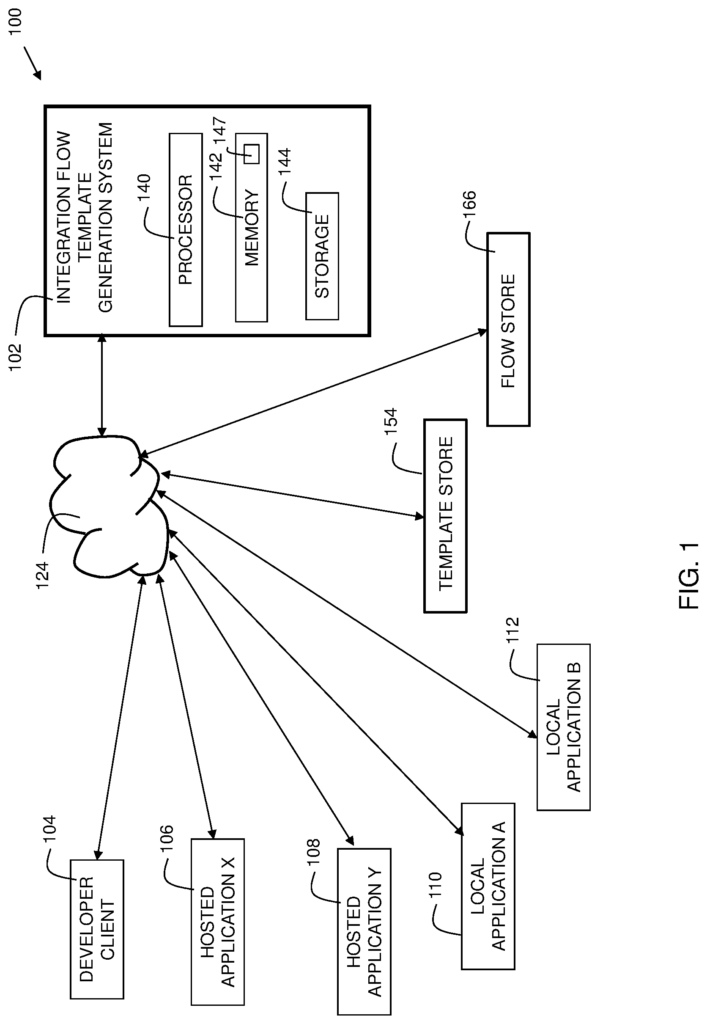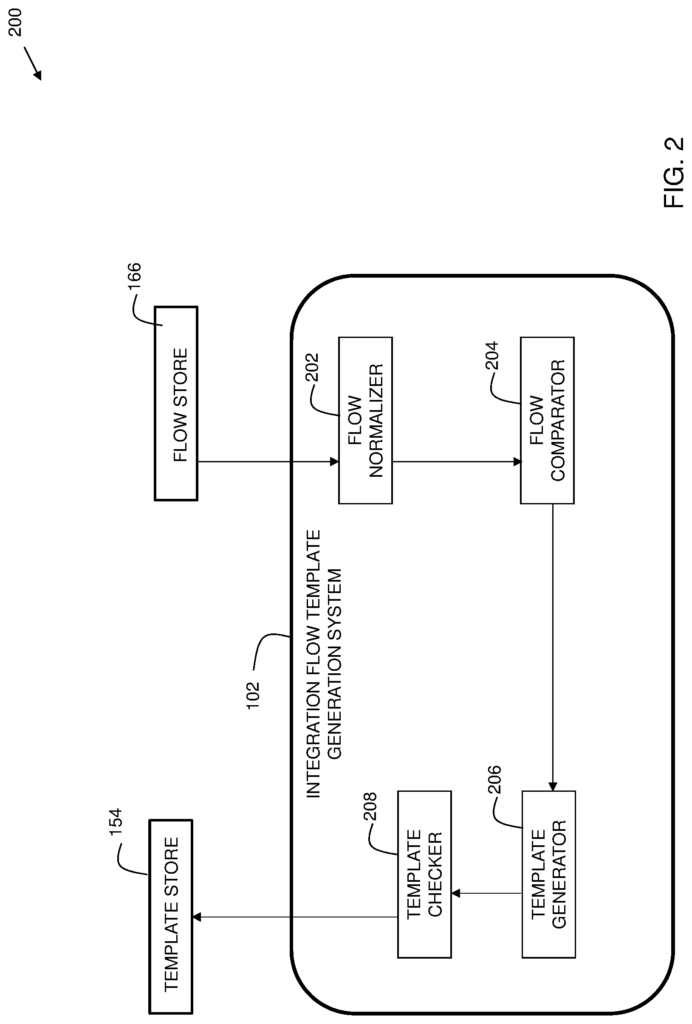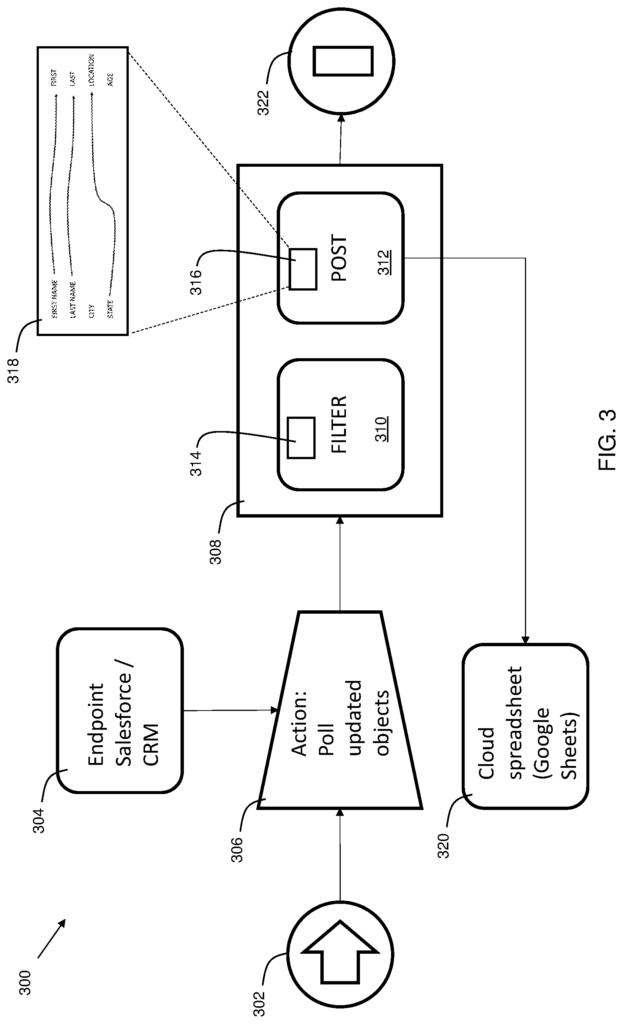Invented by John A. Reeve, Trevor C. Dolby, Matthew E. Golby-Kirk, Andrew J. Coleman, International Business Machines Corp
In today’s fast-paced business environment, companies rely on various software applications to manage different aspects of their operations. However, these applications often operate in silos, leading to data fragmentation and inefficiencies. Integration templates offer a solution by providing a standardized framework for connecting these applications, eliminating the need for custom coding and reducing the time and effort required for integration.
The market for integration template generation is driven by several factors. Firstly, the increasing adoption of cloud-based software solutions has led to a proliferation of applications that need to be integrated. Integration templates simplify the process of connecting these applications, enabling businesses to leverage the full potential of their software stack.
Secondly, the rise of digital transformation initiatives has highlighted the importance of data integration. Companies are increasingly looking to harness the power of data analytics and artificial intelligence to gain insights and make informed decisions. Integration templates enable the seamless flow of data between different systems, ensuring that businesses have access to accurate and up-to-date information.
Furthermore, the market for integration template generation is fueled by the growing demand for automation. Businesses are seeking ways to automate repetitive tasks and streamline their workflows. Integration templates provide a foundation for automation by enabling the integration of different systems and triggering actions based on predefined rules and conditions.
The market for integration template generation is highly competitive, with several vendors offering a range of solutions. These vendors provide a variety of integration templates tailored to specific industries and use cases. Some vendors focus on specific software applications, while others offer more comprehensive integration platforms that support multiple systems.
Integration template generation vendors differentiate themselves through various features and capabilities. These include the ability to handle complex data transformations, support for real-time data synchronization, and scalability to accommodate growing business needs. Additionally, vendors may offer additional services such as consulting, training, and ongoing support to ensure successful integration projects.
As the market for integration template generation continues to grow, businesses should carefully evaluate their integration needs and choose a vendor that aligns with their requirements. It is essential to consider factors such as ease of use, flexibility, and compatibility with existing systems. Additionally, businesses should assess the vendor’s track record, customer reviews, and security measures to ensure a reliable and secure integration solution.
In conclusion, the market for integration template generation is expanding rapidly as businesses recognize the need for efficient and streamlined processes. Integration templates offer a standardized framework for connecting different software applications, enabling data sharing and automation. With the increasing adoption of cloud-based solutions, digital transformation initiatives, and the demand for automation, integration template generation is set to become an essential component of modern business operations.

The International Business Machines Corp invention works as follows
Disclosed embodiments improve integration template generation.” In embodiments of the invention, users analyze existing customer integration flow patterns using computer-implemented techniques, and create templates that capture general patterns seen in these existing customer integration flow patterns. By removing proprietary or identifying data, the customer integration flows can be anonymized. Customer integration templates are created based on real-world use, and can better reflect the needs of the customer than traditional templates, which are created by someone who imagines how the applications should be linked, rather than based on the actual usage. The disclosed embodiments generate integration templates that are based on patterns that have been encountered by many users. These templates can be used as a starting point for anyone who wants to integrate similar applications.

Background for Integration Template generation
Modern enterprise application development uses an integration platform to allow developers to quickly and easily connect applications, allowing them to exchange data. It allows for easy integration of systems that use different technologies, including XML JSON HTTP. Integration flows are used to describe data flow between applications and the processing of inputs and outputs. Integration templates are a good way to simplify the development of an application. Integration templates play a crucial role in the development of applications as more and more customers expect interoperability between multiple applications.
The computer-implemented method of generating integration flow template is described in one embodiment. It comprises: selecting from a plurality customer integration flow groups a group that contains normalized integration flows, selecting randomly a normalized integration flow in the group, selecting the normalized integration flow as the base flow, creating a new template by creating points of variation for fields with different values, between the base and one or several customer integration flow flows in the group, and sending the completed template to a store for qualification.
The following electronic computation device is described in another embodiment: “Another embodiment provides an electronic computing device that comprises: a processor coupled to a memory, the memory containing instruction, which when executed by a processor performs the steps of selecting a customer flow group from a plurality; normalizing customer flows in the selected group to create a set of normalized flows; selecting randomly a normalized flow from the normalized group as a base; creating a new template by creating points of variability between the base and one
The computer program product is a computer-readable storage medium with program instructions embedded therein. These program instructions are executable by a CPU to cause an electronic computation to perform the following steps: selecting a customer integration group from a plurality; normalizing the customers integration flows to create a customer integration group; selecting randomly a normalized flow from the normalized group as a base; creating a new template by creating points of variability between the base and one or several customer integrations flows from the group; and sending the newly created template to
Disclosed embodiments improve integration template generation.” In embodiments of the invention, users analyze existing customer integration flow patterns using computer-implemented techniques, and create templates that capture general patterns seen in these existing customer integration flow patterns. By removing proprietary or identifying information, the customer integration flows can be anonymized. Integration templates are created based on real-world use, and can better reflect the needs of the customer than traditional templates, which are created by someone who imagines how the applications are linked together but are not based upon how they are actually used. The disclosed embodiments generate integration templates that are based on patterns that have been encountered by many users. These templates can be used as a starting point by any user who wants to perform similar integrations.
Reference to “one embodiment” throughout this specification is encouraged. ?an embodiment,? “Some embodiments” or similar language indicates that a feature, structure or characteristic described with respect to the embodiment is present in at least one embodiment. The phrase ‘in one embodiment’ is used to indicate this. “In an embodiment”, “in some embodiments” and similar language throughout this specification may not all refer to the same embodiment. “in an embodiment” and “similar language throughout this specification could, but not necessarily, refer to the same manifestation.
The described features, characteristics, or structures of the invention can be combined in any way suitable in one or several embodiments.” The skilled person will understand that the present invention can be modified and varied without departing from its spirit, scope and purpose. The present invention is intended to cover all modifications and variations that fall within the scope and equivalents of the appended claim. “Now, we will discuss in more detail the preferred embodiments.
FIG. The environment 100 is shown in FIG. 1. The system 102 for generating integration flow templates has a memory 142 and a storage 144. Instructions 147 are stored in memory 142. When executed by processor, these instructions implement embodiments of invention. System 102 is a computing device. “Integration flow” is a term used to describe the flow of data between two or more applications. As used herein, an?integration flow’ is a description for the flow of information between two or more apps. In some embodiments the applications include enterprise applications such as Salesforce and LinkedIn.
Developer Client 104 is an user computing device” (e.g. PC, laptop etc.). On which an application can be installed. The developer can load a template (which could be implemented as an online service) from the integration flow templates generation system 102 and customize it in order to create the required integration flow.
Hosted applications Y 108 and X 106 can be used to represent enterprise-level host applications. These applications could be cloud-based. These applications are popular with many users and used in electronic communication, ecommerce, and business. Salesforce and Insightly are examples of these applications.

Local application A 110 and B 112 may be hosted on internal systems within a company, such as the local servers of that enterprise.
The “Template Store 154” stores integration flow templates. The templates can be used by application developers to create operational customer integration flow for deployment. The term “customer integration flows” is used to describe this. This disclosure is a reference to an integration flow that an organization uses for its specific purposes when interacting between multiple applications.
The Flow Store 166 is a repository for customer integration flows. These flows can be created from templates by application developers and deployed by clients.
FIG. Block diagram 200 of FIG. 2 shows additional details about embodiments of the invention. Referring to FIG. 2, reference 102 is a system for generating integration flow templates. 1). Flow store (also shown in FIG. “Flow store 166 (also on FIG.
Flow normalizer” 202 renames or reorders nodes of flows retrieved from flow store 166. Nodes are functional blocks that can interact with applications in input or output capacities. A node, for example, may receive data as input from an application, such as a CRM (e.g. Salesforce). A node can process data from Salesforce by filtering it based on criteria specified by the user. Another node can send data to another app, such as Google Sheets.
Nodes are associated with various properties, such as dependency information. Information about the input data source is included in dependency information. Node A receiving input data from B creates a dependency. Node B must be placed before node A in the integration flow because nodeA needs the data from nodeB to process nodeA. Node A is not dependent on node for any input data if it does not depend upon node.
Embodiments can identify node dependency and reorder the nodes that do not depend on each other, based on alphabetical order or the application with which the node is interacting. Normalization is the process of reordering. If the change in order does not have an impact on the integration flow, then a flow with an initial order of B-A can be normalized into A-B. The criteria of node independence can be used to reorder the nodes. Node independence occurs when a node does not depend on another node for data input. In this situation, the nodes can be reordered by name or another alphanumeric identification. This reordering simplifies comparison operations. A flow pool can be used to describe the entire set of customer integration flows. In some embodiments, a selected group of customer-integration flows is used to generate a template. In embodiments, there are three to ten customer integration flows within the group. Embodiments may include reordering the nodes alphabetically by name of each customer integration flows in the group based on node independence criteria.
The flow normalizer 202 creates multiple normalized customer integration streams by normalizing a number of integration flows. The flow comparator 204 is more efficient if the flows are normalized before they are input.
In some embodiments normalizing the plurality customer integration flows includes reordering each node alphabetically by its name. Nodes which depend on input data from an upstream element are not reordered to be in front of that element. Nodes without a dependency on input data can be reordered alphabetically by node name or another alphanumeric identification.
Flow comparator” 204 compares similar flows. As a base flow, a normalized flow of customer integration is randomly chosen from a group consisting of a plurality of normalized flows. The group can be a subset from the plurality formed by the same starting node or another suitable criteria. The base flow is given a similarity score. The similarity score measures the similarity between the base flow and each of the normalized customer integration flow plurality.

Click here to view the patent on Google Patents.

Leave a Reply